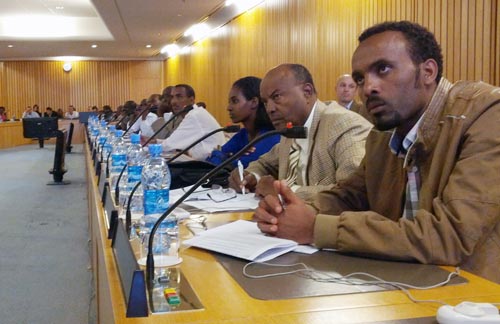 An exhausting, productive day on Day Two of Wheat for Food Security in Africa. Participants arrived bright and early for expert presentations and round-table discussions on abiotic/biotic stresses, market and seed systems, wheat systems and quality, and country outlooks.
An exhausting, productive day on Day Two of Wheat for Food Security in Africa. Participants arrived bright and early for expert presentations and round-table discussions on abiotic/biotic stresses, market and seed systems, wheat systems and quality, and country outlooks.
After lunch things got really interesting as participants gathered to discuss the key constraints for having profitable, productive wheat systems in Africa, and how we can overcome these. One rapporteur from each group presented the findings and these will be consolidated tomorrow before we present the findings to key policy makers, ministers, and donors on Thursday. Here are some things I learnt today…
We can do more if we act together
And this applies on so many levels. Farmers in Africa generally produce crops from very small parcels of land. This discourages large investments on their behalf, because they will never be able to get large returns from just a small area. Some scientists suggested that farmers should join together and farm larger plots. The same applies for inputs such as fertilizer and seed. One of the reasons these things are so expensive in Africa is due to the high transaction costs; if farmer cooperatives bulk-bought these inputs, they would be able to pass on the savings to the farmers themselves. At a national level, participants called for a strengthening of seed systems, and this includes encouraging the involvement of the private sector. Finally, as Hans Braun, Director of CIMMYT’s Global Wheat Program, pointed out, whilst we have many regional agricultural organizations in Africa, such as ASARECA, CORAF, and CCARDESA, “they do not know each other”. If international trade, regulations, and wheat policies are to be improved, it is key that all these players work together.
A value chain is only as strong as its weakest link
Breeders work hard to develop new, disease resistant, high-yielding varieties, yet many farmers do not know about them, and the yield difference between experimental stations and farmers’ fields can be huge. This is not to say that farmers are at fault, or in fact that any one part of the value chain is. It comes back to the above point of working together. We need extension workers to inform farmers about new varieties and to disseminate the improved technologies for agronomy and farm mechanization. We need government support to fund these extension workers. We need policymakers to inform government of the needs of the agricultural sector. But as pointed out by Victor Kommerell, Program Manager for the WHEAT CRP, the research heads of national systems are policymakers, too. And it’s not just the politicians we want to influence and get their attention, it’s the millers, the seed companies, the grain traders, in fact, anyone with a vested interest in wheat should be listening to African researchers and learning about the huge market that exists on this continent.
There is a solution for wheat in Africa
It’s simple maths. Increased revenues and decreased production costs equal increased profits and greater incentives for growing wheat in Africa. Aside from the points mentioned above, it’s clear we need more research and knowledge, and for this knowledge to be shared between researchers, governments, extension workers, community leaders, farmers. Timely access to fertilizer is a major problem for Africa, but we could overcome this by increasing capacity in fertilizer production, assisting farmers with credit access, and ensuring that everyone who needs to use fertilizer knows exactly how much to use and when to apply it. Human capacity is also key and countries must invest in their own agricultural researchers and extension workers. And none of these things will be truly successful without effective communication at all levels.
With a whole day of discussions, it’s hard to do little more than scratch the surface in a 600-word blog. Hopefully you have a little insight into our progress in Addis Ababa,
and we’re looking forward to bringing you more updates from the conference on Thursday. Tomorrow you can still follow us as we go to the field – look for our twitter hashtag #W4A and join us as we visit research stations and farmers at Kulumsa and Debre Zeit. You can also read what other people have been saying about the conference; so far, we have had stories published on La Presse, Bloomberg, Reuters, Scientific American, Phys.org, Voice of America, Deutsche Welle, and Times Live.
 Nutrition, health and food security
Nutrition, health and food security 
